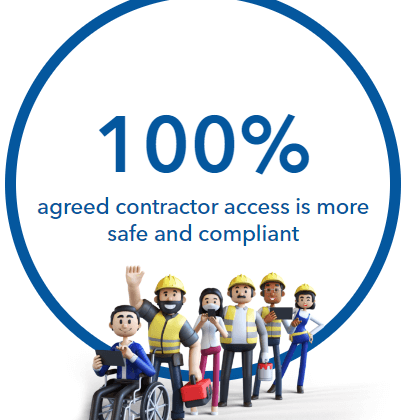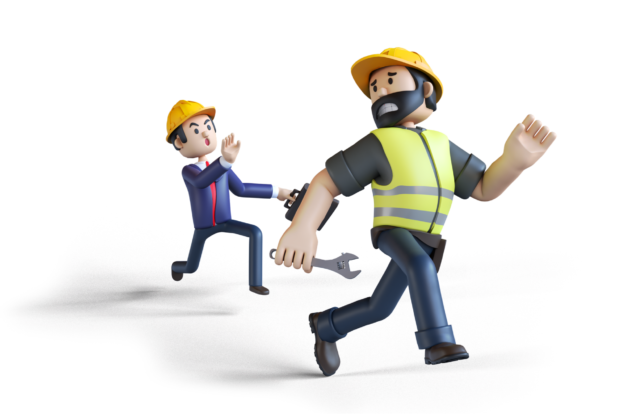- Why Verature?Find out why Verature is the best system for continuous contractor compliance.
- Arrive, Work & Stay Safe
- Removes Paper & Spreadsheets
- Tracks Key Contractors
- Instant 360 Visibility
- Contractor Management Dashboards
- Why Contractor Management Software
- Our Customer Reviews
- Pricing
We don’t hide behind fancy sales teams before we tell you, our prices.- Clients
See who we are working with and what they have to say about Verature.- Resources
Check out our blog, useful guides, whitepapers and product videos.- Prequalification and Induction Guide
- Contractor Compliance Guide
- Mini-Audit your Permit to Work System
- Health and Safety Audit Checklist
- Resource Library
- Blog
Book a demo
Arrive Safe: The Ultimate Guide to Contractor Pre-qualification and Induction
Book a demoThis guide will cover how to safely bring a contractor onto site. From the pre-qualification stage, through to the qualification of contractors, to ensure you a successful and safe, project outcome.
This guide is intended to provide you with best practices for bringing contractors safely onto site, and introduces various methods including using Verature as a contractor management software and compliance platform to help you pre-qualify, select, onboard and qualify your contractors. Whether you are a client, a contractor or a recruiter, this guide will help you understand and follow the steps and procedures involved in the contractor management process, from pre-qualification to qualification.
What are your obligations as Client or Contractor?
As a client, your duty is to ensure that the contractors you hire are competent, qualified and compliant with the relevant legal, environmental and health and safety regulations and standards. You also have a responsibility to cooperate and coordinate with other clients who share the same site or contractors, and to consult with the workforce and their representatives about the selection and management of contractors.
As a contractor, you have a duty to ensure that you and your workers are competent, qualified and compliant with the relevant legal, environmental, and health and safety regulations and standards. You also have a responsibility to cooperate and coordinate with the client and other contractors on site, and to follow the client’s instructions, policies and procedures.
Key Terms and Definitions
In this guide, we will use the following key terms and acronyms:
- Pre-qualification: the information gathering and assessment process used to determine whether a contractor’s capabilities, capacities, resources, management processes, and performance are suitable for a project.
- Selection: the process of choosing the most suitable contractor for a specific project based on the project requirements and criteria.
- Onboarding: the process of integrating the selected contractor into the client’s organization and providing them with the necessary contracts, agreements, policies, induction, training, and communication.
- Qualification: the process of evaluating and verifying the contractor’s performance and compliance during and after the project execution.
- SSIP: the Safety Schemes in Procurement, a mutual recognition scheme for occupational health and safety management among construction-related schemes.
Contents
- Section 1: Contractor Pre-Qualification
- 1.1 What is Contractor Pre-Qualification?
- 1.2 What are the Challenges of Contractor Pre-Qualification?
- 1.3 Why Contractor Pre-Qualification Matters for your Project?
- 1.4 Overcoming Contractor Pre-qualification Challenges
- 1.5 Best Practices when Prequalifying Contractors
- 1.6 Criteria and Standards to Prequalify Contractors
- 1.7 How a Centralised Contractor Management System Facilitates Pre-Qualification
- Section 2: Best Practices for Contractor Selection
- Section 3: Contractor Onboarding & Induction
- Section 4: Contractor Qualification
- 4.1 What is contractor qualification?
- 4.2 What performance evaluation criteria should you use to assess contractor performance?
- 4.3 What tools can you use to carry out performance evaluations?
- 4.4 How can a contractor management system help with ongoing contractor performance and compliance monitoring?
- 4.5 How to supervise the work of contractors, workers and subcontractors?
- Section 5: Introducing a Contractor Management System
Section 1: Contractor Pre-Qualification
1.1 What is Contractor Pre-Qualification?
Contractor pre-qualification is the preliminary stage in the bidding process where the goal is to determine whether a contractor has the resources and experience required to complete the job successfully. It is a way of assessing the suitability of potential contractors before inviting them to bid for a project or join a preferred supplier list.
Contractor pre-qualification involves reviewing the contractor’s history, experience, qualifications and references. It also involves checking their health and safety information, insurance documentation, quality and safety accreditations and policies. This process helps to ensure that the contractor meets the standards and expectations of the client, as well as the legal and regulatory requirements of the country in which they operate.
Contractor pre-qualification can benefit both the client and the contractor by:
- 1. Reducing the risk of accidents, incidents, and non-compliance penalties.
- 2. Improving the quality and efficiency of the project delivery.
- 3. Saving time and money by streamlining the tendering process.
- 4. Enhancing the reputation and trust of both parties.
- 5. Fostering a positive and productive working relationship
Contractor pre-qualification can take various forms, such as a health and safety questionnaire, a standardised pre-qualification questionnaire (PQQ), a specific accreditation scheme (e.g. CHAS or Safe Contractor) or a combination of all. The aim is to provide a common minimum standard for construction procurement and demonstrate the contractor’s commitment to high standards of health and safety, legal compliance and qualification to do the works.
Contractor compliance is about ensuring adherence to rules and safety standards throughout the contractor’s journey, from pre-arrival to departure, ensuring workplace safety. An integral part of that is controlling the documentation surrounding contractor compliance.
1.2 What are the Challenges of Contractor Pre-Qualification?
Contractor pre-qualification is a critical process for businesses that want to ensure they work with dependable and skilled suppliers. However, it is not a simple or easy process.
Some of the common difficulties that procurement, technical, projects, facilities or engineering teams encounter when conducting contractor pre-qualification are:
- Managing the pre-qualification process with a manual system: Many businesses still rely on manual methods and systems, such as Excel spreadsheets, to gather and store contractor information. This can be slow, prone to errors, and ineffective, as the data may be old, wrong, or incomplete. It can also cause information gaps and lack of transparency across the supply chain.
- Not being able to collect relevant compliance information from each supplier: Compliance is a crucial aspect of contractor pre-qualification, as it ensures that the contractors comply with the legal and regulatory requirements, as well as the client’s standards and expectations. However, obtaining and checking compliance information can be difficult, as the questionnaires may not be tailored to the specific job or industry, and data may not be annually audited or verified.
- Relying on lagging indicators to evaluate contractor safety performance: Safety is another important factor to consider when pre-qualifying contractors, as it affects the project quality, schedule and reputation. However, many businesses use lagging indicators, such as injury rates and incident records, to measure contractor safety performance. While they provide a snapshot to spot a potential red-flag, these indicators are not reliable, as they are based on past events, often statistically insignificant and normally not audited. They do not reflect the current or future safety performance of the contractors, nor do they capture the proactive measures that the contractors take to prevent accidents.
- Communicating and collaborating with multiple contractors and stakeholders: Communication and collaboration are essential for successful contractor management, as they ensure that everyone is on the same page, aligned with the project goals and aware of their roles and responsibilities. However, communicating and collaborating with multiple contractors and stakeholders can be challenging, as it involves different channels, formats and expectations. It can also lead to confusion, misunderstanding and conflict, especially if there are changes or issues during the project.
By tackling the challenges of contractor pre-qualification and using the best practices and tools, businesses can enhance their contractor selection and management process, and achieve better outcomes for their projects.
1.3 Why Contractor Pre-Qualification Matters for your Project?
Contractor prequalification is the process of evaluating and verifying the qualifications, capabilities and compliance of potential contractors before inviting them to bid on a project. It is a crucial step for ensuring that only the best and most suitable contractors are selected for the project, and that they meet the standards and expectations of the project owner and the general contractor.
You have a role and responsibility when it comes to pre-qualification of contractors?
All parties have responsibilities. The roles and responsibilities of the client, contractor and recruiter in the pre-qualification stage are as follows:
- The client is responsible for defining the project requirements and criteria, creating and sending the pre-qualification questionnaire, reviewing and approving the contractor’s credentials, scoring and ranking the contractor’s responses, and selecting the shortlisted contractors for the next stage.
- The contractor is responsible for completing and submitting the pre-qualification questionnaire, providing the required credentials, complying with the relevant regulations and standards, and expressing their interest and availability for the project.
- The recruiter is responsible for sourcing and screening potential contractors, facilitating communication and coordination between the client and the contractor, and providing support and guidance to both parties throughout the pre-qualification process.
Contractor prequalification can bring many benefits to any project, such as:
- Improving the quality and performance of the contractors: they are assessed based on their past experience, expertise, and reputation in similar projects.
- Reducing the risk and liability of the project: as the contractors are screened for their financial stability, insurance coverage, legal status and safety record.
- Saving time and cost of the project: the prequalification process can eliminate unqualified or unreliable contractors, and avoid potential delays, disputes or claims.
- Enhancing the safety and sustainability of the project: the contractors are required to demonstrate their compliance with the relevant health, safety and environmental regulations and best practices.
- Increasing the transparency and accountability of the project: the prequalification process can provide a clear and consistent criteria and documentation for evaluating and comparing the contractors.
1.4 Overcoming Contractor Pre-qualification Challenges
To overcome the challenges at pre-qualification stage, businesses need to adopt a systematic and strategic approach, as well as leverage the appropriate tools and software, such as Verature. These solutions can help with:
- Sending and receiving pre-qualification questionnaires and documents
- Evaluating and comparing the contractors based on their pre-qualification results
- Providing a register of approved/unapproved contractors
- Managing and updating the contractor information and documentation
- Providing real-time reporting and auditing of contractor compliance
- Integrating with other contractor management functions, such as induction, permits and performance review
1.5 Best Practices when Prequalifying Contractors
The prequalification stage is the process of screening and evaluating contractors before they are invited to bid for the project or task. The purpose of this stage is to ensure that the contractors meet the minimum requirements and standards for the work, and to flag any unqualified or unsuitable contractors. The best practices of contractor selection at the prequalification stage are:
- Establish clear and consistent selection criteria and standards. The business should define the scope and specifications of the project or task, and identify the requirements and expectations for the contractors. The selection criteria and standards should be based on the nature and complexity of the work, as well as the business objectives and priorities. The selection criteria and standards should be clear, consistent and measurable, and communicated to potential contractors in advance.
- Use a customised and comprehensive pre-qualification questionnaire. The business should use a pre-qualification questionnaire to collect and evaluate the information and documents provided by the potential contractors. The pre-qualification questionnaire should be customised and comprehensive, covering various aspects of the contractor’s profile, such as experience, expertise, certifications, compliance with regulations and the ability to manage risks. The pre-qualification questionnaire should also include questions that are relevant and specific to the project or task, such as the contractor’s proposed approach, methodology, and resources.
- Conduct background checks and interviews with potential contractors. The business should conduct background checks and interviews with potential contractors to verify and validate their information and credentials. The background checks should include checking the contractor’s references, past performance, reputation and financial stability. The interviews should include asking the contractor questions about their qualifications, experience, skills and knowledge, as well as their understanding of the project or task, and their expectations and concerns.
1.6 Criteria and Standards to Prequalify Contractors
The criteria and standards for selecting suitable contractors for the project depend on the nature, scope and complexity of the project, as well as the client’s expectations and requirements. Some of the common criteria and standards include:
- The contractor’s experience, expertise, and reputation in the relevant field or industry.
- The contractor’s financial stability, insurance coverage, and risk management practices.
- The contractor’s quality management, environmental management and health and safety management systems and policies.
- The contractor’s availability, capacity and resources to deliver the project on time, on budget, and on quality.
- The contractor’s compliance with the relevant legal, environmental and health and safety regulations and standards.
1.7 How a Centralised Contractor Management System Facilitates Pre-Qualification
A centralised contractor management system, like Verature, automates the collection, management, and requalification (annual audit) of minimum criteria and standards, such as health and safety information, documents and forms.
Verature’s built-in customisable questionnaire and credential approval process allows you to easily pre-qualify your contractors based on their capabilities, capacities, resources, management processes and performance. You can use Verature to:
- Create a customised pre-qualification or a health and safety questionnaire that covers the criteria and standards that are relevant to your project and organisation.
- Send the questionnaire to the contractors who are interested in applying for the project, and receive their responses electronically and securely.
- Review and accept the contractor’s credentials, such as certificates, licenses, accreditations, references, and testimonials, using Verature’s document repository and verification system.
Once you’ve gone through your pre-qualification process, Verature also provides a secure and centralised contractor database of approved contractors, where the business can easily access and update contractor profiles, credentials and compliance status and use Verature to help when it comes to selecting a contractor to fulfil a particular project or job.
Section 2: Best Practices for Contractor Selection
2.1 What is contractor selection?
The process and criteria for choosing the most suitable contractor for a specific project depends on the nature, scope and complexity of the project, as well as the client’s expectations and requirements. Some of the common steps and criteria include:
- Defining the project specifications, deliverables, outcomes, timeline, budget and quality standards.
- Inviting the shortlisted contractors from the pre-qualification stage to submit their proposals, bids or tenders for the project, and providing them with the necessary information and instructions.
- Evaluating and comparing the contractor’s proposals, bids or tenders based on their technical, financial and managerial aspects, and their alignment with the project specifications and criteria.
- Negotiating and finalising the terms and conditions of the contract, agreement or policy with the selected contractor, and ensuring that they are clear, fair and enforceable.
- Awarding the contract, agreement or policy to the selected contractor, and informing the other contractors of the outcome and the reasons for the decision.
2.2 Contractor Selection Best Practices: Choosing the right contractor for the job
The selection stage is the process of assessing and verifying the suitability of contractors for a specific project or task. You may be selecting from your pre-qualified list of approved contractors. Whilst this stage is often done outside of your contractor safety management system with the assitance of procurement or purchasing teams, it would be a mistake to focus purely on the commercials at this stage. The purpose of this stage is to ensure that the selected contractors have the necessary skills, knowledge experience and resources to complete the work safely, efficiently and to the required standards.
The best practices of contractor selection are:
- Compare and rank the contractors based on their pre-qualification results. The business should compare and rank the contractors based on their pre-qualification results. The comparison and ranking should be done objectively and systematically, using a scoring or weighting system that reflects the importance and relevance of each selection criterion and standard. The comparison and ranking should help the business to identify the strengths and weaknesses of each contractor, and to narrow down the list of the most qualified and suitable contractors for the work.
- Check and validate the contractor credentials and documents. The business should check and validate the contractor credentials and documents, such as licenses, certifications, insurance and contracts. The business should ensure that the contractor credentials and documents are valid, current and compliant with the applicable laws and regulations. The business should also review and understand the terms and conditions of the contractor contracts, and negotiate any changes or amendments if necessary.
- Use leading indicators, such as safety culture and behavior, to evaluate contractor safety performance. Whilst most PQQ’s now ask about accidents and incidents, the business should use leading indicators, such as safety culture and behavior, to evaluate the contractor safety performance, rather than relying solely on lagging indicators, such as accident rates and injury statistics. Leading indicators are proactive and predictive measures that reflect the contractor’s commitment and attitude towards safety, such as safety training, audits, inspections and feedback. Leading indicators can help the business to identify and address any potential safety issues or hazards before they escalate into accidents or injuries.
- Communicate and collaborate with the selected contractors throughout the project lifecycle. The business should maintain regular and effective communication and collaboration with the selected contractors throughout the project lifecycle. The business should establish clear and open channels of communication and information exchange with the contractor, such as meetings, reports and updates; pre-start meetings and toolbox talks are a common method for achieving ongoing communication. The business should also monitor and supervise the contractor work progress and quality, e.g. through audit and onsite inspections, and provide feedback and guidance as needed. The business should also foster a positive and cooperative relationship with the contractor, and resolve any conflicts or problems promptly and amicably.
How a contractor management system can help with contractor selection
A contractor management system often becomes your database of approved contractors – or those that have met your minimum standards during the pre-qualification of contractors. A contractor management system, such as Verature, can help with contractor selection in a number of ways:
- Filter contractors by various criteria, such as location, availability, rating and compliance status, and view their profiles and contact details.
- Verature can help to maintain and annually audit your register of contractors, thus you can select contractors based on up-to-date information.
- You may also select from contractors who have already undertaken your onboarding procedures, and thus benefit from faster lead times to project start date.
- Invites contractors to upload and maintain information regarding their workers, workers’ competencies, skills and training.
- View compliance and performance data about contractors from previous projects or jobs, thus enable the business to use leading indicators, such as safety culture and behavior (utilising modules such as Red and Yellow Cards and Audit reports, for example), to evaluate contractor safety performance, rather than relying solely on lagging indicators.
- Compare and select the most suitable contractors for the project based on project requirements and criteria, and invite them to participate in the project.
Read our essential guide for more info.
Section 3: Contractor Onboarding & Induction
3.1 What is contractor onboarding?
Onboarding is the process of integrating the selected contractor into the client’s organisation and providing them with the necessary contracts, agreements, policies, induction, training and communication.
It is different from onboarding full-time employees, as contractors are usually hired for specific projects or tasks, and have more flexibility and autonomy in their work. Of course, this also exposes contractors, the project and your site to greater risk. Onboarding external contractors can help you ensure that they are qualified, compliant and engaged with your company’s goals and values. Some of the steps involved in onboarding external contractors are:
- Collecting and verifying their contact details, credentials and references
- Signing and saving all the required legal documents, such as contract, NDA and IP agreement
- Collecting and sharing their payment information with your finance team
- Providing them with the necessary tools, resources and access to the work area
- Training them on your safety instructions, policies and procedures
- Assessing their knowledge and compliance with your health and safety questionnaire
- Assigning them a risk rating and monitoring their performance and feedback
A system like Verature can help you streamline and automate your contractor onboarding process, by providing you with a self-service portal where you can pre-vet and approve your contractors, set the job requirements, notify them to complete and maintain their compliance records, share your site safety induction with a multi-choice assessment and monitor and track your contractor or subcontractor’s status with digital badges.
3.2 Contractor onboarding: Inductions & Assessments
As an employer or a client, you have a duty to provide information, instruction and training to contractors and their workers who carry out work for you. This is to ensure that they can work safely and without risk to their health or the health of others.
The information, instruction and training you provide should be:
- Relevant to the work they are doing and the risks involved
- Clear and easy to understand
- Suitable for the level of competence and experience of the contractors and their workers
- Provided before they start work and updated whenever there are changes
- Recorded and monitored for effectiveness
What should your contractor induction include?
Some of the information, instruction and training you may need to provide as part of the induction and supplementary information includes:
- Your health and safety policy and procedures
- The hazards and risks associated with the work and the site
- The control measures to prevent or reduce those risks
- The emergency procedures and contacts
- The roles and responsibilities of the contractors, their workers and your staff
- The reporting and recording requirements for incidents, accidents and near misses
- The use and maintenance of any equipment, tools or personal protective equipment
- The standards and expectations for the quality and performance of the work
- The feedback and communication channels for any issues or concerns
What format should it take?
You can provide information, instruction and training in various ways, such as:
- Written documents, such as contracts, manuals, handbooks, checklists, posters or leaflets
- Verbal communication, such as briefings, meetings, toolbox talks or phone calls
- Visual aids, such as signs, labels, diagrams or videos
- Practical demonstrations, such as showing how to use equipment or perform a task
- Online platforms, such as websites, apps or e-learning modules
- Induction and assessment programmes, such as Verature’s External Contractor Portal, which allows you to share safety instructions and inductions with contractors before they arrive on site, and Verature’s induction assessment which allows you to assess their knowledge and compliance
- Supervision and mentoring, such as assigning a supervisor or a mentor to oversee and support the contractors and their workers
- Feedback and evaluation, such as asking for feedback from the contractors and their workers, reviewing their work and providing constructive criticism and recognition
You should also consult with the contractors and their workers and their representatives about the information, instruction and training you provide, and involve them in the planning and delivery of it. This will help to ensure that it meets their needs and expectations and that they are engaged and motivated to follow it. You should also review and update the information, instruction and training regularly, and check that it is effective and achieving the desired outcomes.
How Verature Helps with Inductions
Verature’s external contractor portal may be used to share safety instructions and inductions with contractors. A multi-choice assessment follows, which can be used to assess contractor knowledge and compliance and guide future face-to-face instruction. The client gains complete oversight as to which contractors have passed their induction and can control access to site and issue of work permits accordingly.
Read more in the
Verature BlogSection 4: Contractor Qualification
4.1 What is contractor qualification?
Contractor qualification is the process of performance evaluation of the contractor both during and after the project execution.
How a contractor management system can help with contractor qualification
Best practices can be maintained by using management tools such as Verature. Verature monitors the company and contractor compliance levels in real-time and provides alerts and reports on any issues or gaps. It allows the business to use leading indicators, such as safety culture and behaviour (utilising modules such as Red and Yellow Cards/ 3-strike rules, for example), to evaluate contractor safety performance, rather than relying solely on lagging indicators, such as accident rates and injury statistics. Verature also enables the business to record feedback and perform on-site audits on contractor work, which can be used when assessing for future works during the pre-qualification and selection process. While communication tools help to foster a positive and cooperative relationship between the contractor and client.
4.2 What performance evaluation criteria should you use to assess contractor performance?
The criteria and standards for assessing contractor performance and compliance during and after the project execution depend on the nature, scope and complexity of the project, as well as the client’s expectations and requirements. Some of the common criteria and standards include:
- The contractor’s adherence to the contract specifications, deliverables, outcomes, timeline, budget and quality standards.
- The contractor’s compliance with the relevant legal, environmental and health and safety regulations and standards.
- The contractor’s satisfaction and feedback on the project and the client’s management and supervision.
- The contractor’s contribution to the project’s objectives, benefits and risks.
- The contractor’s performance and compliance history and improvement.
4.3 What tools can you use to carry out performance evaluations?
To assess the contractor’s performance and compliance, the client or the principal contractor should use a variety of methods and tools, such as:
- Monitoring and auditing the contractor’s activities, deliverables, outcomes and documents, using digital tools, such as the Verature Contractor Management System.
- Reviewing and evaluating the contractor’s work and providing feedback and guidance.
- Measuring and comparing the contractor’s performance and compliance against the agreed criteria and standards, using tools such as Verature’s Project and Job Dashboarding and Digital Badges for performing on-site inspections on Workers.
- Conducting surveys, interviews or focus groups with the contractor and their workers, and other stakeholders involved in the project, to collect their opinions and suggestions.
- Investigating and reporting any problems, incidents or near-misses involving the contractor and their workers, and implementing corrective or preventive actions.
The assessment of the contractor’s performance and compliance should be done regularly and consistently throughout the project, and at the end of the project. The results of the assessment should be recorded and documented, and shared with the contractor and their workers, and other stakeholders. The results of the assessment should also inform future contractor selection and pre-qualification processes.
4.4 How can a contractor management system help with ongoing contractor performance and compliance monitoring?
An effective contractor management system not only helps by centralising contractor documentation, projects, permits and activities, making it easy to visualise what is going on and thus where you might need to focus your attention on performing reviews and audits of works, but can also help provide tools to capture performance and compliance data.
Verature’s digital badges provide an efficient way to perform on-site inspections. Challenge contractors via scanning their digital badges’ QR code, and perform a number of checks:
- Check all documentation is in place
- Verify issued work permits
- Confirm induction status
- Review job details and ensure they’re working on approved works
- Verify workers are checked on-site and working in approved areas.
Verature’s mapping functionality enables you to visualise all projects, permits by status and on-site contractors. Making it easy to hone in on hotspots of activity and plan inspections and audits.
Record results of inspections and audits, record near-misses and incidents and use Verature’s Red and Yellow Card module to highlight non-conformances, lessons learnt and preventative actions.
While systems can help provide a range of tools to achieve oversight of contractor activities and methods for reporting results of performance and compliance audits, it is thus important to have clear objectives and an understanding of what items you need to pay attention to whilst performing inspections and audits.
4.5 How to supervise the work of contractors, workers and subcontractors?
Managing and supervising the work of contractors and their workers is a key responsibility of the client or the principal contractor, depending on the nature and size of the project. The main objectives of managing and supervising contractors are to:
- Ensure that the work is carried out safely, efficiently and in accordance with the contract specifications and the agreed health and safety plan.
- Monitor the progress and quality of the work and provide feedback and guidance to the contractors.
- Coordinate and communicate with the contractors and other parties involved in the project, such as designers, consultants, subcontractors and regulators.
- Resolve any issues or conflicts that may arise during the work and prevent or minimise any disruptions or delays.
- Review and approve any changes or variations to the work scope, schedule or budget.
- Ensure that the work is completed on time, within budget and to the required standards.
What actions should you take to put into place effective contractor supervision and management?
Some of the actions that can help to manage and supervise the work of contractors and their workers are:
- Establish clear roles and responsibilities for the client, the principal contractor, the contractors and their workers, and document them in the contract and the health and safety plan.
- Conduct regular site inspections and audits to check the compliance and performance of the contractors and their workers, and record the findings and actions taken.
- Hold frequent meetings and briefings with the contractors and their workers to review the work plan, the risks and the control measures, and to communicate any updates or changes.
- Provide adequate information, instruction and training to the contractors and their workers on the site rules, procedures, equipment and emergency arrangements.
- Use digital tools, such as Verature’s Contractor Management System, to streamline and automate the management and supervision of the contractors and their workers, such as issuing digital permits, tracking contractor locations, reviewing contractor performance and contractor annual audits.
Steps to deal with problems or incidents involving contractors and their workers
Problems or incidents involving contractors and their workers can have serious consequences for the health and safety of the people, the environment and the project. Therefore, it is important to deal with them promptly, effectively and professionally. Some of the steps that can help to deal with any problems or incidents involving contractors and their workers are:
- Stop the work immediately and secure the site if there is any danger or potential harm to anyone or anything.
- Report the problem or incident to the relevant authorities, such as the client, the principal contractor, the health and safety representative, the regulator or the emergency services, depending on the severity and the nature of the problem or incident.
- Investigate the cause and the extent of the problem or incident and collect any evidence, such as photographs, documents, witness statements or samples.
- Identify and implement any corrective or preventive actions to prevent recurrence or escalation of the problem or incident, such as repairing or replacing any damaged equipment, revising or updating any procedures or policies or providing additional training or supervision.
- Record and document the problem or incident and the actions taken, and keep a log of all the problems or incidents that occur during the project.
- Review and evaluate the effectiveness of the actions taken and the lessons learned from the problem or incident, and share them with the contractors and their workers and other stakeholders.
This underscores the importance of effective communication during the onboarding and induction phase of contractor management and having tools in place to document where incidents do occur, for lessons learnt and future decision-making regarding selection and project management.
Read more in the
Verature BlogSection 5: Introducing a Contractor Management System
5.1 How Can Verature Help with Prequalification, Onboarding and Induction?
Leveraging software systems like Verature ensures you are performing necessary checks at pre-qualifiation and annual audit, and have full information available to you about how contractors have performed on previous jobs for you, when selecting contractors for projects. They also help establish communication channels and ensuring contractors have consumed and understood your site safety rules and expectations before attending site. Systems help with automating data collection and compliance checks, making it easier for teams to make safer, more informed choices at this crucial stage.
How Verature’s tools help
Now, let’s explore in greater detail how Verature Contractor Management System can be instrumental in smoothly navigating this difficult stage of contractor management:
Verature’s Features:
- Comprehensive Compliance Tracking: Verature’s robust system offers an all-encompassing solution for tracking contractor compliance. It allows organisations to meticulously monitor various aspects of compliance, including contractor qualifications, certifications, safety records, insurance coverage, and more. Real-time dashboards and reports provide unparalleled visibility into compliance status, allowing organisations to stay on top of their contractor workforce’s adherence to regulatory standards.
- Automated Checks: Verature ensures that contractors meet the requisite criteria before commencing work. Automated alerts are triggered to promptly notify parties of any compliance gaps, enabling swift corrective actions.
- Performance Tracking: Challenge workers and perform on-site inspections utilising digital badges. Record near-misses. Implement a 3-strike rule with Verature’s Red and Yellow Card module.
- Efficient Communication: Verature facilitates streamlined communication between client, contractor and worker. It automates notifications related to document submissions, renewal reminders and induction requirements. This automation significantly reduces communication gaps, fostering clear and timely communication.
- Real-time Reports: Reports offer invaluable insights into performance, allowing organisations to make informed decisions regarding contractor selection.
Learn how Verature’s 8-stage efficient process improves contractor management. 5.2 Real-world Examples of Businesses Benefiting from Verature
Businesses from diverse industries have successfully utilised Verature to enhance their contractor prequalification and onboarding efforts.
Wellcome Trust Case Study: Elevating Contractor Compliance with Verature
Wellcome Trust, a prominent charitable foundation focused on improving global health, approached Verature to update their process. Verature’s Contractor Control System provided them with a customised solution, streamlining their contractor management process. Key benefits included automation, centralisation of data and enhanced communication. Wellcome Trust now enjoys real-time updates and data sharing across the organisation regarding contractors, incidents and events.
“The team at Verature deserve a round of applause; they have made this a really easy project to manage and have been brilliant at understanding our requirements and delivering Verature, the Shift Handover and our Induction Video. We would not hesitate to recommend the Verature system.”
Read full case studyJo Grunert Facilities & Workplace Project Manager
Sibelco Case Study: Streamlining Compliance Across Multiple Sites with Verature
Sibelco, a global material solutions company, sought a modern, cloud-based solution to manage contractor profiles and inductions across 19 sites. Verature enabled Sibelco to establish a structured and standardised induction process, replacing manual methods like punch cards and spreadsheets. The result was increased efficiency, improved health and safety procedures and a complete overview of workers’ induction status across all sites.
“The Verature system has been really well received at Sibelco; it’s clean and user friendly. We now have a complete overview of our visitors and contractors on each of our sites to ensure they’ve completed the required inductions. The system is making it easy to ensure we are remaining accountable for the safety of our contractors when on site.”
Read full case studyWendy Brunt Operations Administrator
Collins Aerospace Case Study: Enhancing Contractor Management with Verature
Collins Aerospace, a leader in aerospace and defence solutions, collaborated with Verature to streamline their contractor management. The Verature Contractor Management System optimised their daily operations and provided complete visibility of contractor activity. Through Verature, they streamlined contractor inductions, automated document collection and improved communication between different departments.
These examples showcase how organisations have experienced substantial improvements in their prequalification, induction and ongoing qualification of contractors through implementing Verature. Verature’s solutions have successfully provided streamlined methods to verify contractors and improved communication and collaboration with their contractors.
5.3 Reducing exposure to risk with Verature
Verature plays a pivotal role in mitigating risk and optimising resources:
- Risk Mitigation: By ensuring that contractors consistently comply with safety regulations, possess the necessary qualifications, and maintain up-to-date insurance coverage, Verature helps organisations mitigate the substantial risks associated with not undertaking a robust prequalification process. This proactive approach safeguards organisations against potential financial, legal and reputational damages.
- Resource Efficiency: Verature’s centralised data management helps organisations to allocate both internal and external resources more judiciously.
- Safety Awareness: Ensuring the contractor induction is up to standard and complete by bringing that, along with an assessment, into Verature, helps companies ensure that their minimum expectations and site safety standards are communicated and understood, every time without failure. Ensuring the induction is repeated regularly through automated reminders direct to workers, ensures a consistent approach and in the long term, contributes to a more general safety awareness.
- Enhanced Decision-making: Verature equips organisations with data-driven insights into their contractors. These insights empower informed decision-making in critical areas such as contractor selection.
Read more in the
Verature BlogConclusion
In conclusion, ensuring the safety of contractors as they come onto a site is paramount. It involves a comprehensive process that includes careful selection, thorough pre-qualification, detailed onboarding, and consistent induction practices. By adhering to these steps, businesses can create a safe working environment that minimises risks and promotes a culture of safety. It’s essential to select contractors who demonstrate a strong commitment to health and safety, provide them with the necessary information, instruction and training, and ensure that safety policies are strictly followed. Ultimately, the goal is to foster a collaborative effort where both client/employers, contractors and subcontractor understand their roles and responsibilities in maintaining a safe and healthy workplace
Contact Verature today for a comprehensive demonstration of how our system can revolutionise this important stage of contractor management.

















